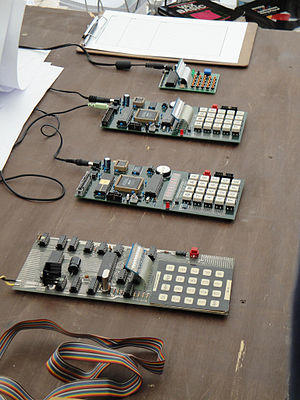 MK14 (foreground) with modern reproductions behind | |
| Also known as | MK14 |
|---|---|
| Manufacturer | Science of Cambridge |
| Type | computer kit |
| Release date | 1977[1] |
| Introductory price | GB£39.95 |
| Units sold | 15,000[2] (another source states 50,000[3]) |
| CPU | National Semiconductor SC/MP (INS8060) |
| Memory | 256 bytes of RAM (expandable to 640 bytes) |
| Display | 8 or 9 red light-emitting diode (LED) seven segment display |
| Input | 20 key keyboard |
The MK14 (Microcomputer Kit 14) was a computer kit sold by Science of Cambridge of the United Kingdom, first introduced in 1977 for GB£39.95.[1] The price was very low for a complete computer system at the time,[1][4] and Science of Cambridge eventually sold over fifteen thousand kits.[2]
History
In 1977, Ian Williamson approached Clive Sinclair and Chris Curry with a computer design based around the National Semiconductor SC/MP processor. Sinclair and Curry both liked the idea and saw the potential of making a low cost microprocessor system available to the hobbyist market. Initially it was planned to market a kit based on the Williamson design. However, after National Semiconductor had been contacted regarding a bulk purchase of the SC/MP processor Sinclair and Curry decided to use the chip manufacturer's own design. This design used all National Semiconductor chips and the company allowed the use of its design for free.[2][4]
To keep costs low a membrane keypad was used. The size of the initial batch was two thousand. The company sold between fifteen and fifty thousand in total.[2]
Specification
The computer is based around National Semiconductor's SC/MP CPU (INS8060) and shipped with 256 bytes of random access memory (RAM) as standard. It used an eight or nine red light-emitting diode (LED) seven segment display, there was also optional VDU supporting 32×16 text or 64×64 graphics. Input and output was a 20-key keyboard and reset switch. Cassette-based and PROM storage were optional extras; a sound card was not included but a design for one was provided.
The on-board RAM could be increased in two ways; by the addition of an INS8154N RAM/IO chip providing an additional 128 bytes of RAM along with 16 I/O lines, and also a further 256 bytes by adding two 256 × 4 bit RAM chips giving a maximum of 640 bytes on board. These memory spaces were not contiguous in the memory map. It was possible to connect off-board RAM giving a 2170 bytes total.
The MK14 could address up to 64 KB of memory space by adding a few chips (the NADS address strobe indicated when the most significant four bits of address were available to be captured by an external latch); many pioneering homebrew computer magazines such as Personal Computer World, and Practical Electronics carried details of user modifications.
See also
Notes
- ^ a b c "Planet Sinclair: Computers: MK 14: Articles: PE 5/79". www.nvg.ntnu.no.
- ^ a b c d "Ian Williamson: The engineer who gave Sinclair his first micro".
- ^ Sinclair, Planet. "Planet Sinclair: Computers: MK 14". rk.nvg.ntnu.no.
- ^ a b Computerphile (15 November 2017). "1978's Raspberry Pi (MK14) - Computerphile" – via YouTube.
External links
- MK14 manual
- Old-computers.com dedicated page, article, pictures, documents and videos
- The Sinclair / Science of Cambridge MK14 Web Site, includes emulator software
- Making a reproduction MK14 – includes original manuals/schematics